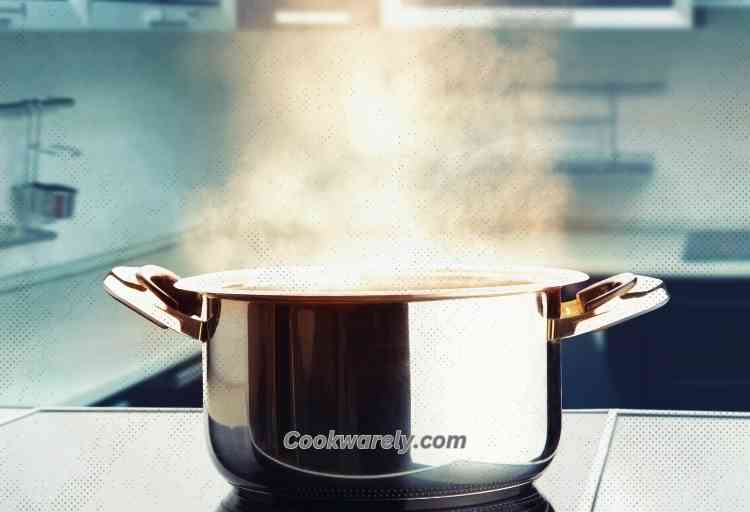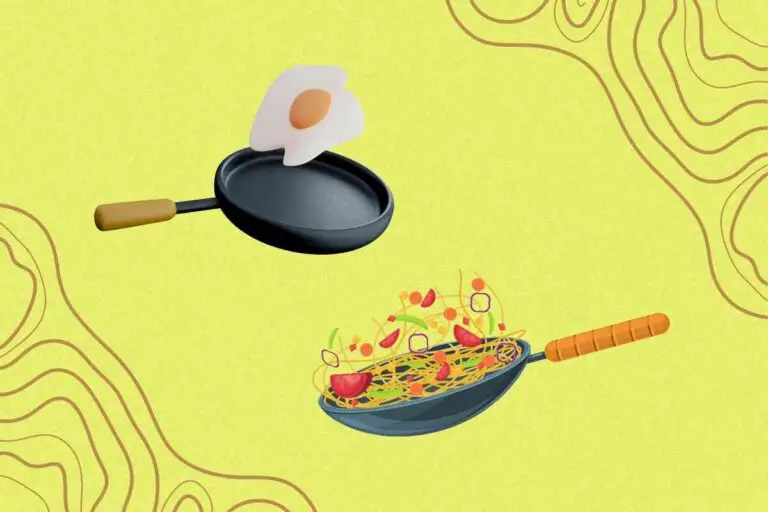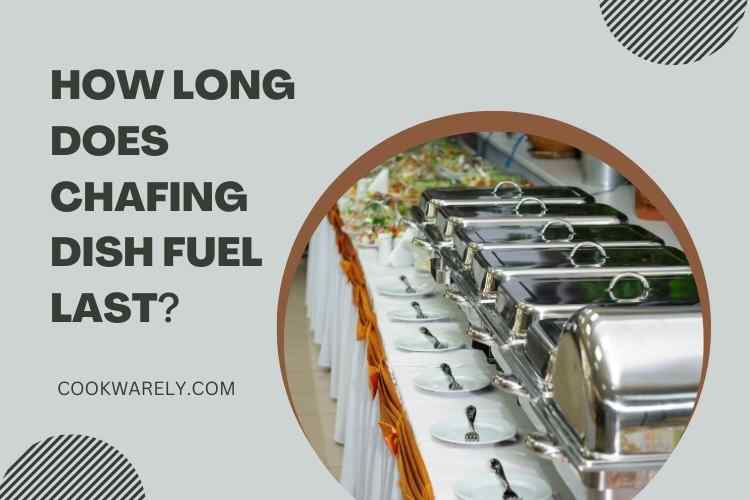9 Factors: Can You Deep Fry In A Nonstick Pan
Can You Deep Fry In A Nonstick Pan? Yes, you can deep fry in a nonstick pan, but there’s a catch. The USDA suggests keeping the temperature between 350°F to 375°F. However, regular deep frying in a nonstick pan isn’t advisable because it can harm the nonstick coating.
These pans aren’t meant for high-temperature frying. Even though the nonstick material can handle about 620°F, it’s best to avoid extreme heat to maintain your pan’s quality.
9 Considerations When Deep Fry in a Nonstick Pan
| Consideration | Details |
|---|---|
| Temperature | Maintain a range of 350°F to 375°F for best results. |
| Nonstick Coating | Avoid regular deep frying, as it can damage the coating. |
| Oil Quantity | Use an appropriate amount of oil to submerge food adequately. |
| Food Preparation | Ensure food is dry and properly coated with batter or flour. |
| Utensils | Use non-metallic utensils to prevent scratching the coating. |
| Monitoring | Continuously monitor and adjust the heat to prevent overheating. |
| Cleaning | Hand wash gently; avoid abrasive scouring pads. |
| Frequency | Limit deep frying in nonstick pans to preserve their longevity. |
| Alternative Cookware | Consider using dedicated deep fryers or cast iron pans for high-temperature frying. |
Key Takeaways
- Maintain a temperature range of 350°F to 375°F for safe deep frying in a nonstick pan. Avoid high heat that can damage the nonstick coating.
- Use a modest amount of oil to prevent overfilling the pan, which can lead to soggy food and potential smoking.
- Ensure your ingredients are free of excess oils or fats before adding them to the pan.
- Heat the pan over medium heat to avoid burning the food, and remove it from the heat source once your food reaches the desired crispiness.

Five Facts About Deep Frying in a Nonstick Pan
- Deep frying in a nonstick pan is feasible within a temperature range of 350°F to 375°F. This range allows for safe frying without compromising the nonstick coating.
- Nonstick pans are not designed for high-temperature frying. Regular deep frying can damage the nonstick coating over time, reducing its effectiveness.
- To avoid making your food overly greasy, it’s essential to use a conservative amount of oil when deep frying in a nonstick pan. Excessive oil can lead to soggy results.
- Using too much oil or overheating the pan can lead to smoking. It’s crucial to stay within the recommended temperature range and oil quantity to prevent this.
- To extend the lifespan of your nonstick cookware, limit deep frying in these pans and consider using alternative cookware designed for high-temperature frying, such as dedicated deep fryers or cast iron pans.
What Is A Nonstick Pan?
A nonstick pan is a cooking utensil that doesn’t require any kind of coating. The food doesn’t stick to the pan and it’s easy to clean.
Some pans are coated in Teflon, a material that is resistant to heat and wear. However, some pans are made with a special coating, which makes them nonstick.
How to Deep Fry in a Nonstick Pan?
So you’ve decided to try to deep fry in a nonstick pan. You’re wondering how to make sure you get a nice and crispy exterior and moist interior. Well, let’s take a look at the best way to do this.
Step 1. Preparation is Key
Before you start, ensure your ingredients are free of excess oils or fats. Although nonstick pans can handle some frying, they’re not built for high temperatures.
Step 2. Add the Right Amount of Oil
Begin by adding a small amount of oil to the pan. Avoid overfilling to prevent sogginess and potential smoke.
Step 3. Heat Gently
Set the pan to medium heat; avoid going higher. Gradual heating prevents food from burning.
Step 4. Prepare Your Food
While the pan heats up, cut your food into the desired size and place it into the pan.
Step 5. Fry to Perfection
Cook the food for approximately 3 to 4 minutes, or until it achieves the desired crispiness.
Step 6. Remove and Rest
Once cooked, remove the pan from the heat source. Let the food cool for a few minutes before serving.
How Do You Prevent Food From Spattering?
Deep frying in a nonstick pan is an effective way to experiment with different foods. However, you need to be careful not to burn or stick the food. Here are a few tricks to help you avoid this common problem.
- Always check your oil temperature before you start frying. If you see a drop of water in the oil, reduce the heat. You don’t want the water to boil, so you’ll have to adjust the heat accordingly.
- Don’t let the food touch the sides of the pan. As you’re cooking, be sure to move the food around a little, otherwise it can stick to the side of the pan and burn.
- If you notice smoke coming from the pan, turn down the heat. If you can’t turn it off, remove the food immediately.
- You can add some flour to the food before you fry it. This helps prevent the food from sticking to the bottom of the pan.
- When you’re done cooking, drain the excess oil. This way, you can reuse it for another batch of food.
Do You Have to Use Nonstick Pans?
Of course, we know that nonstick pans are the best option. They save you time by making cleaning up much easier, and they’re made to last.
However, you can use other pans to deep fry in. For example, you can use cast iron skillets, stainless steel pans, or a standard oven-safe pan.
How to Deep Fry in a Nonstick Pan?
It’s a bit trickier than usual, but it’s not impossible. You can follow these steps to deep fry in a nonstick pan:
- Preheat the oven to 200 degrees Fahrenheit.
- Add 1/2 cup of cooking oil to the bottom of a skillet.
- Add your food to the skillet.
- Cook on medium heat for about 3-5 minutes.
- Place the food on a baking sheet to finish cooking.
- Once the food is done, remove it from the pan and place it on a paper towel to absorb excess grease.
What Is the Best Pan for Deep Frying?
There are many types of pans for deep frying with different sizes, shapes, and materials. Each type has its pros and cons.
The most common pan for deep frying is the deep fryer. These pans are usually made from heavy gauge metal. They’re expensive, but they do the job perfectly.
There are also nonstick frying pans that are made of nonstick material. While these pans are much cheaper than their metal counterparts, they can sometimes lead to the food sticking to the surface of the pan.
There are also cast iron pans. These pans are very heavy and durable. They’re best for high-temperature cooking such as searing meat.
Finally, you can get rid of all the hassle by using a regular frying pan. While these pans can’t deep fry, they work well for smaller items such as vegetables.
How Do You Know If You Can Deep Fry in a Nonstick Pan?
If you’re thinking “deep frying is only for chicken and potatoes,” you’re missing out on a ton of delicious options. You can deep fry pretty much anything, from chicken and fish to doughnuts, pizza crusts, and even pasta.
Deep frying is a perfect way to experiment with new flavors. Just follow these simple steps and you can deep fry anything!
Step 1: Buy a Nonstick Pan
You need a nonstick pan for deep frying. There are two types of nonstick pans; coated and uncoated. Coated pans are generally better for deep frying.
They contain an inner coating that prevents the food from sticking. You can buy an uncoated nonstick pan, but they’re more expensive and they require cleaning.
Step 2: Add the Oil
Add oil to the nonstick pan. The best oils to use for deep frying are coconut oil, peanut oil, and canola oil. You can also use vegetable oil if you want.
Step 3: Heat the Oil
Heat the oil over a medium-low heat for about five minutes. When you add the oil to the pan, it will start to bubble and pop.
Step 4: Add the Food
Add your food to the nonstick pan. The key here is to cover the food with oil. You don’t want any air pockets.
Step 5: Deep Fry the Food
To deep fry, heat the oil until it is hot enough to cook the food. Don’t heat the oil too much because you want to keep the temperature steady.
Step 6: Take the Food out
Take the food out when it’s golden brown. To ensure that the food is cooked all the way through, make sure that the food is cooked for at least five minutes on each side.
Step 7: Drain the Oil
After you’ve deep-fried the food, remove it from the nonstick pan. Let it drain on paper
How To Clean Your Nonstick Pan?
While you can buy a nonstick pan that is already cleaned, you can also clean it yourself. Follow these steps to clean your nonstick pan.
- Use a soft cloth to wipe off the inside of the pan.
- Do not use soap, as it will leave residues that can clog up the pan.
- Wipe the inside of the pan with a wet towel.
- Let the pan dry completely before you start using it again.
What Oils are Best for Non-Stick Pan?
The secret to a non-stick pan is a non-stick surface. Non-stick pans are coated in a layer of Teflon, a material that won’t react with the oils in your food.
You can find non-stick pans in most kitchen stores. They usually come with a package of oil that’s specifically made for the non-stick surface.
While using a non-stick pan can lead to less cleanup, you’ll need to be careful with the type of oil you use.
Some oils are too sticky to work well with non-stick pans, so you need to choose the right type of oil for your non-stick pan.
For example, if you use a non-stick pan to cook fish, you might want to avoid using olive oil or vegetable oil. These oils tend to be too thick to work well with non-stick surfaces.
Instead, you should use vegetable oil such as corn oil or peanut oil.
Conclusion
Deep frying in a nonstick pan is possible, but it comes with specific considerations. Maintaining the right temperature range, using a moderate amount of oil, and being mindful of the nonstick coating’s sensitivity are key factors for success.
While it can be done occasionally, it’s advisable to limit deep frying in nonstick pans to preserve their longevity.
For high-temperature frying, exploring alternative cookware options like dedicated deep fryers or cast iron pans is a wise choice.






